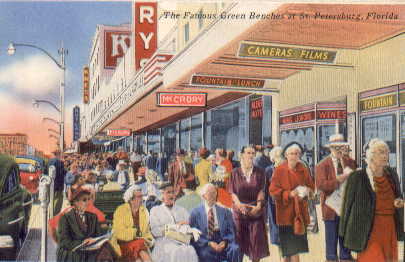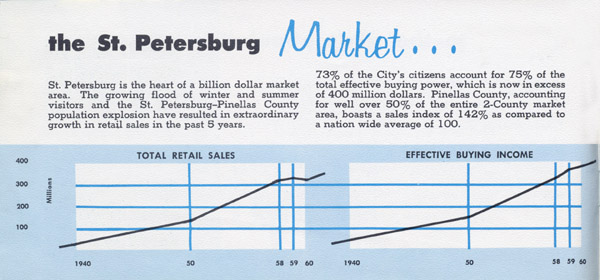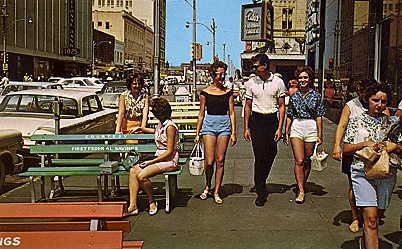
Pre-Air History of WTVT
GETTING CHANNEL 13 ON THE AIR WASN'T A PRETTY PICTURE!

St. Petersburg in the late 40's. A
great place to relax and enjoy the sunshine.
Sit on one of the green benches along Central Avenue or slip into McCrory's for a soda.
Listen to WTSP or WSUN radio. But don't buy that TV just yet...
Until the early 1950's Tampa Bay had the reputation of being a place for older folks and retirees. After World War II a growing number of young families took up permanent residence to enjoy the year-round higher temperatures, nearby recreation on sunny beaches and a growing consumer economy. The expanding population with their greater spending power made Tampa Bay a natural market for the new medium of television.

This chart was issued by the St. Pete Chamber
of Commerce
to show the area's amazing post-war growth.

The green benches soon would be gone, but these younger
types won't miss them.
When they're not skiing, swimming, or playing golf,
they're watching Channel 13!
Television did not arrive in Tampa Bay until 1953. WSUN-TV, Channel 38, signed on Memorial Day weekend and it took another two years for channels 8 and 13 to begin broadcasting. Who was responsible for all the delays? Why, the federal government, of course!
Station to Station
In the late 1940's, The Federal Communications Commission (F.C.C.) was overwhelmed with applications for television licenses. With Channel 1 reserved for use by the military, VHF (Very High Frequency) channels 2 through 13 were allocated for commercial use. The government saw a logjam of applicants in the making and there was also great concern that VHF signals of stations in one market would infringe on signals of stations in other markets.
In 1948 all applications for VHF television licenses were frozen by the F.C.C. in order to evaluate the available spectrum and set guidelines for awarding licenses around the country. A number of stations in the country's largest cities were already on the air by that time, but emerging markets such as Tampa Bay were left out in the cold while government studies and hearings on allocation of frequencies delayed the television boom for four long years. A relatively new broadcast technology, U.H.F. (Ultra High Frequency) offered some relief for the crowded VHF spectrum by adding UHF channels 14 through 83 to the mix. This allowed room for 617 VHF, 1436 UHF, and 242 educational/non-commercial television licenses. The F.C.C. freeze was lifted early in 1952 and the race was on for broadcast licenses across the nation.
But first the applicants had to jump through some F.C.C.-erected hurdles. In the early days of television broadcasting, CBS, NBC, ABC, and Dumont were not supplying enough programming to fill an entire day. Hoping that local stations non-network programming would be used for local news, education, or programs in the public interest, the F.C.C. was very interested in learning what the license applicants were planning to do with the time allocated for their non-network schedules.
The FCC's guidelines for awarding licenses also called for diversification, as explained in this press release:
"In a long line of cases we have established the principle that diversification of the media of mass communication is desirable, and that in the absence of countervailing considerations, a grant to an applicant with fewer broadcast interests or who is not associated with other radio or newspaper interests better serves the public interest."
There was, however, a 'Catch 22' to this situation.
Businessmen interested in starting a television station would need to secure an enormous amount of capital. On average, studio facilities, cameras, transmitters, and staff would mean an initial investment in the hundreds of thousands of dollars. Despite the F.C.C.'s wish for diversification, deep-pocketed newspaper chains were among the first to be able to finance television operations. Lacking suitable competitors for a license, the F.C.C. would often grant a franchise to newspapers that additionally owned local radio stations. In 1953, 69% of ALL television stations were owned by newspapers. The positive side of this situation is that some local stations carried on a journalistic tradition inherited from their newspaper management.